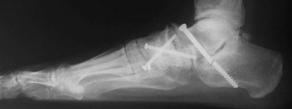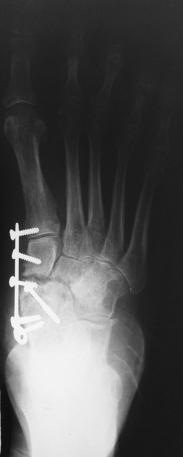Complications of Arthrodesis and Nonunion
Keywords
• Nonunion • Fusion • Bone healing • Pseudoarthrosis • Internal fixation
Arthrodesis has long been used as a viable surgical option by many foot and ankle surgeons. Joint fusions have historically been viewed as a good choice for those patients whose particular foot and ankle pathology requires a definitive, stabilizing procedure.1 Some of the more common conditions addressed by fusion include trauma, arthritis, and congenital or developmental malalignment syndromes.1 Arthrodesis is often an ideal solution for a painful or degenerated joint; unfortunately, the procedure does not come without a set of potential complications that can prove to be challenging.
Complications of joint fusions can include those applicable to any surgery such as bone and/or soft-tissue infection, wound dehiscence, and failure of fixation. Other complications are specific to fusion procedures and would include malalignment, proximal or distal joint deterioration, and delayed union or nonunion.1 The latter negative outcomes can occur from medical comorbidities, patient noncompliance, or inappropriate fixation.
Principles of arthrodesis and bone healing
As with any surgical condition, the decision-making process is paramount to the success of the case. The selection of a joint fusion procedure is made with the knowledge that the affected joint will no longer have its intended function and motion.1,2 In most cases this is a beneficial consequence because the joint structure has already lost its motion or structural integrity through injury or degeneration, leaving the patient with pain and loss of function. Arthrodesis can eliminate patient’s pain while providing stability of the previously malfunctioning or nonfunctioning joint.1,2 However, there are examples when the surgeon may opt to fuse a joint prophylactically to avoid future problems; such is the case following severe fractures involving a joint. It is important to weigh the advantages against the disadvantages before undertaking this kind of preemptive fusion.
Arthrodesis requires diligent anatomic dissection, complete articular cartilage resection, accurate realignment, and stable fixation. These concepts are critical for primary bone healing to take place.2
Bone healing can be separated into primary or secondary healing.3,4 Primary bone healing occurs with rigid stabilization enhanced by compression, and preservation of vascularity. It occurs with either contact or gap healing, where the gap is less than 2 mm.3–5 This type of bone healing involves Haversian remodeling, where cutting cones phagocytose osteoids and lay down new lamellar bone. Secondary bone healing can also lead to successful arthrodesis, but is considered less desirable because there is micromotion and an extra bone callus formation phase.3,4 The less the stability and callus formation, the more delay there will be for complete bone healing.
Causes of complication and nonunion
There are several types of complications of arthrodesis. For the purpose of this discussion they are separated into technical and biologic complications.6–8
Technical complications relate more to the surgeon and include poor surgical selection, execution of procedure, or inadequate fixation and/or stabilization (Fig. 1). Patient noncompliance can play a large role in the problems, due to fixation and stability. These complications are often a result of ill-prepared surgery and are often avoidable.2
Arthrodesis procedures are among the most technically challenging and demanding procedures for the foot and ankle surgeon. Adequate training and experience is paramount to the success of the procedure. Dissection of the fusion site that fails to preserve the neurovascular supply will undoubtedly result in a decreased healing capacity.7,8 In some cases, disruption of vascular supply can lead to avascular necrosis, and nerve damage can also lead to a condition called complex regional pain syndrome.
Even with completed fusion, poor alignment will cause problems with stability, gait, shoe fit, and patient function.8 Finally, inadequate fixation can allow motion across the arthrodesis site and lead to delayed union or nonunion, and possibly displacement of reduction (Fig. 2).6–8
Biologic complications are those that arise from physiologic sources, making them difficult to fully control or avoid. The most prevalent biologic complication is a surgical infection. Surgical infections are not common; however, the likelihood can increase in patients with certain medical comorbidities. Any condition that may cause the patient a decrease in immune response can increase the patient’s chance of a surgical infection. These conditions include, but are not limited to, diabetes mellitus, peripheral vascular compromise, immunosuppression, and tobacco use.9,10 Numerous studies have shown that any one of these conditions will significantly affect healing. Fortunately, the use of perioperative antibiotics is almost universally applicable in fusion cases, and will inevitably minimize the risk. Proper surgical dissection and periosteal and soft-tissue closure must be performed to ensure adequate blood supply. Most important is the concept of patient selection.1–3,7,8 A patient who has significant or multiple comorbidities may not be a candidate for any type of surgical arthrodesis. Other methods for treatment must be used if the risk of complication is too great.
Stay updated, free articles. Join our Telegram channel

Full access? Get Clinical Tree










